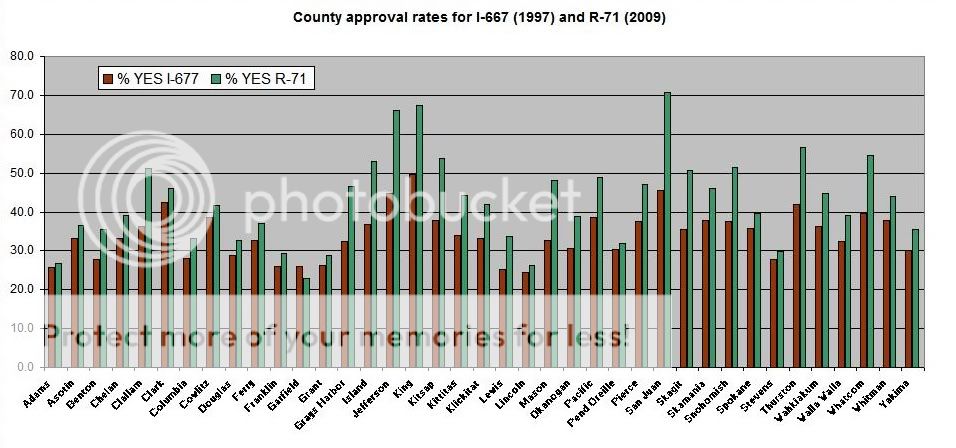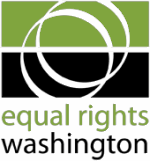 For the 5th year in a row, the number of pro-equality voters in Washington state is increasing. Last week The Washington Poll released the results of their annual fall poll of likely voters on questions including this one:
For the 5th year in a row, the number of pro-equality voters in Washington state is increasing. Last week The Washington Poll released the results of their annual fall poll of likely voters on questions including this one:
Q: Which of the following statements best describes your views on the issue of same-sex marriage?
Gay and lesbian couples should have the same legal right to marry as straight couples.
Gay and lesbian couples should be able to have the same legal rights as stright couples but it should not be called marriage.
There should be domestic partnerships that give gay and lesbian couples only some of the benefits and protections of marriage.
There should be no legal recognition of gay and lesbian couples.
Dunno/Getoffmylawn
The Washington Poll is a non-partisan academic survey research project sponsored by the University of Washington’s Institute for the Study of Ethnicity, Race & Sexuality. They first asked this question in 2006. I combed through previous reports so that we could look at the most recent results in historical context. Looking at the graph above, the positive, unwavering trend towards equality is very clear.
 We saw this statistical trend validated last year when almost 53% of the Washington electorate voted to ratify the new comprehensive domestic partnership law via Referendum 71 (a national first!). A post-election analysis showed that 38 of Washington’s 39 counties had demonstrated an increase in pro-equality voting since the last time an LGBT measure was on the ballot.
We saw this statistical trend validated last year when almost 53% of the Washington electorate voted to ratify the new comprehensive domestic partnership law via Referendum 71 (a national first!). A post-election analysis showed that 38 of Washington’s 39 counties had demonstrated an increase in pro-equality voting since the last time an LGBT measure was on the ballot.
So we’re ready to push for marriage equality in the legislature, right? Well, not so fast.
 The really great news is that fully 29% of voters in Washington State believe gay and lesbian couples should be legally recognized. But from here it gets a little more complicated. The graph to the right should make you drool. I’ve combined the results from the Washington Poll graph above into two pots: voters who support marriage equality or full domestic partnerships, and voters who support limited domestic partnerships or no legal recognition for lesbian and gay couples. In the Land of Wishful Thinking, we’re nearing 70% support when you look at this way. Do not look at it this way. Then why am I showing you this? So that you can see that we have great potential for success in Washington if we marshal our resources over the next 2 years..
The really great news is that fully 29% of voters in Washington State believe gay and lesbian couples should be legally recognized. But from here it gets a little more complicated. The graph to the right should make you drool. I’ve combined the results from the Washington Poll graph above into two pots: voters who support marriage equality or full domestic partnerships, and voters who support limited domestic partnerships or no legal recognition for lesbian and gay couples. In the Land of Wishful Thinking, we’re nearing 70% support when you look at this way. Do not look at it this way. Then why am I showing you this? So that you can see that we have great potential for success in Washington if we marshal our resources over the next 2 years..
Strong support for marriage equality currently polls somewhere close to 40%. Taking a sober look at that number is vital because Washington is a referendum state and any marriage equality law passed by the legislature will almost certainly need to be defended at the polls. The wild card are the 29% percent of voters who support giving same-sex couples all the rights and benefits of marriage but don’t want the legal status called marriage. While many of these voters will ultimately support marriage equality we can’t even count on a majority of them. And here is what we know about how voters actually behave when it comes to marriage referenda and initiatives.
* Pre-election polls consistently underestimate opposition to marriage equality.
* We cannot change voters’ attitudes on marriage equality during the course of an election campaign.
These facts are well known to our leadership in the Washington state Legislature, and Senator Ed Murray for one has said he will file but not push a marriage equality bill until he’s satisfied that the electorate is ready to ratify it at the polls.
Equal Rights Washington’s Executive Director Josh Friedes says we are at the point where we can seriously start talking about winning marriage equality at the ballot box as early as November 2012. According to Friedes, what we need to do over the next 18 months is explain to voters why full domestic partnerships are not equivalent to marriage.

Part of this conversation has to be sharing our personal stories and the stories of people we care about. We need to help people see that domestic partnerships don’t provide the dignity every person is entitled to. Another part of the conversation has to be explaining how domestic partnerships do not attempt to confer the federal protections of marriage such as Social Security protections, immigration rights and equal treatment under the IRS tax code. Lastly we need to address the concerns many voters have, we need to ask adult children of same-sex couples to speak out so that ambivalent voters can see that our children grow up to be productive and well adjusted.
It takes a long time for voters to move on family recognition issues so we need to start now and since the key is personal conversations we need to fund an educational program that allows us to reach out to the 40% of voters who already strongly support marriage equality and ask them to speak to their social networks.
Friedes says that its not so much that the work is hard, as it is costly. In California and Maine the money came too late.
We need to fully fund a comprehensive education program that starts to roll out by mid 2011, if we have any intention of winning marriage on the ballot in November 2012.
So what’s the moral of the story? The latest poll results are incredibly encouraging, but we still have a lot of work to do, and it is work that cannot be put off until some electoral crunch time. I’m game. Are you in?
Pam’s House Blend – Front Page















